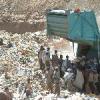 James Greyson Jun 18, 2013 07:01 |
Could you please reassure me about the opportunity costs?
Shouldn't biodegradable wastes be composted and returned to soil? Shouldn't woody wastes be turned into charcoal during the cooking process - and then added to soil?
Does centralised charcoal-making make a lot of pollution from the woodgases and waste a lot of heat that could otherwise be used for cooking/heating etc?
|
 2013wastemanagementjudges 2013wastemanagementjudges Jul 9, 2013 05:19 |
Congratulations, your proposal has been named a finalist in the Climate CoLab Waste management contest. You have until July 20th to edit your proposal. The Judges’ suggest that you focus your edits in the areas listed below.
Small-scale production of charcoal briquettes to meet local needs is an interesting and potentially beneficial idea, but there are major technical aspects which have not been addressed in this proposal:
1. How much charcoal has been produced to date in the pilot and how is it being produced? Have any pilots been undertaken outside of lab settings? (this reviewer thinks that quantities to date must be very low if scale up will produce about 1 ton/day)
2. Which waste fractions are being used? (one cannot reasonably use high moisture content organic/food waste with low lignin; paper waste has high cellulose and low lignin and is not suitable; wood waste is best as it has high lignin conten but wood seems to be locally scarce and one might expect it to be burned directly for fuel)
3. (related question to 2) Is any wood included as feedstock for the proces? If so, what is the potential quantity of the woody feedstock on a daily basis in Nairobi? In the reviewers' experience, most wood in developing countries is re-used in homes or burned for cooking fuel.
4. What fuel is being used for the pyrolysis process? (we inquire because pyrolysis is an energy-intensive high-temperature process)
5. How is the process being controlled (temperature, retention time, oxygen-free environment) to produce a sufficiently-uniform charcoal product for local cooking fuel use?
6. Finally, pyrolysis of wood to produce charcoal generates PAHs (polycyclic aromatic hydrocarbons) and other undesirable emissions, which (at larger scales) can significantly contribute to local air pollution in the absence of expensive emission controls--not so much a problem at micro-scales but appropriate to consider at larger scales. Are there similar undesirable emissions produced by Takachar's process?
Charcoal production in developing countries today tends to be incredibly wasteful, but from what is presented here, it’s not clear how the proposed approach would be more effective.
If the technical questions can be answered convincingly, this could be a promising alternative for developing countries.
|
 2013wastemanagementjudges 2013wastemanagementjudges Jul 31, 2013 02:39 |
The revision did not address some of the key questions raised by the Judges in their initial review. It was not clear from what was written in the proposal how exactly the team was going to make this project happen from a technical perspective.
|
